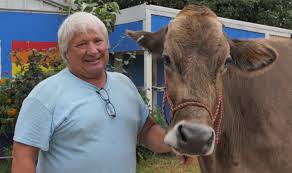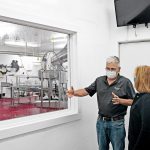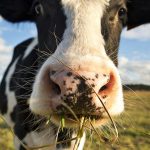
Calvin owns Trails West Brown Swiss Farm, one of approximately 30,000 small dairy farms with fewer than 200 cows nationwide. When his father owned the farm, he was one of a much larger industry. Nationwide, in 1987, there were just under 150,000 small dairy farms.
After high school, Calvin received his master’s degree in social work and started practicing. That was, until he met his wife, Andrea, who is originally from Switzerland. After much consideration, the couple decided a farm would be a good place to raise their children.
Since Calvin was a third-generation dairy farmer, a dairy farm was what the couple decided on. From the beginning, it was difficult, but as the years passed, running a profitable dairy farm kept getting tougher and tougher.
Changing times
Calvin said he missed out on going to many of his children’s activities, as they took place almost always during his evening milkings. In contrast, while he was growing up, the schools geared activities around a farming schedule.
“When I was a kid, a lot of kids were dairymen’s kids,” Calvin said. “That’s not the case with my kids’ friends.”
Even though the business is rough financially, the Nislys said raising dairy cows is very rewarding. Each one of the cows is like family. From Ladyship to Butter to Nestle to Bonfire, each animal has a name and a unique personality, which goes along with their name.
“I get a lot of enjoyment out of my animals,” Andrea said. “They’re good company.”
Similar to nationwide numbers, in Kansas the number of dairy farms is dwindling, with larger farms producing more of the milk. According to the USDA, milk production in the state during August 2020 totaled 338 million pounds. This is up 7% from last year. The average number of milk cows in Kansas was 169,000 head — 7,000 head more than a year ago.
According to the Kansas Department of Agriculture, approximately 80% to 85% of the milk produced in the state is produced in western Kansas on 29 large farms.
“When the virus hit, the co-op market collapsed,” Calvin said.
Although, during some of this time, while sales for milk increased, prices dropped.
Brown Swiss
Since starting his own farm, Nisly raises Brown Swiss, even though his father raised Holsteins. Their 60-count size is typical of the amount of cows dairy farmers had when Calvin was growing up. But in 2013, according to the USDA, the midpoint size on the average dairy farm was 1,300 cows.
The Brown Swiss Association, which was established in 1880, has about 50,000 registered purebreds. Most Brown Swiss reside in Wisconsin, followed by New York and Pennsylvania.
“Brown Swiss are really a good cow,” said Norm Magnussen, executive secretary for the Brown Swiss Association. “They are docile and heat tolerant.”
Brown Swiss have higher butterfat and protein content, making them an excellent breed for producing cheese.
Magnussen said the only way to make money for a small dairy farmer is to go into a niche market, by making a specialty cheese, yogurt or milk product.
Along with being a part of Central Equity Milk Cooperative out of Missouri, Nisly Dairy Farm sells raw milk, as well as eggs from their free range chickens. They are also looking into making yogurt.
“Farming used to be a way of life,” Magnussen said. “Now, (Large) Farmers have become so efficient at making money. If you haven’t figured that market out, you’re going to go out of business (unless you get into a niche market).”

























